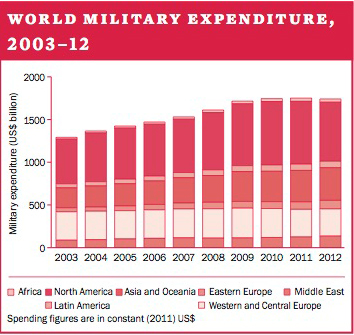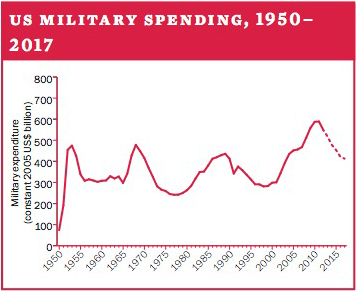3. Military expenditure
- Overview [PDF]
SAM PERLO-FREEMAN
- I. Global developments in military expenditure [PDF]
SAM PERLO-FREEMAN, CARINA SOLMIRANO AND HELEN WILANDH
- II. US military expenditure [PDF]
ELISABETH SKÖNS
- III. Russian military expenditure, reform and restructuring [PDF]
SAM PERLO-FREEMAN
- IV. Security spending and violent organized crime in Central America [PDF]
CARINA SOLMIRANO
- V. Two case studies in the governance of military budgeting and expenditure: Colombia and Indonesia [PDF]
SAM PERLO-FREEMAN AND CARINA SOLMIRANO
- VI. The reporting of military expenditure data to the United Nations [PDF]
CHRISTINA BUCHHOLD
- VII. Military expenditure data, 2003–12 [PDF]
SAM PERLO-FREEMAN, WAEL ABDUL-SHAFI, CHRISTINA BUCHHOLD, CARINA SOLMIRANO AND HELEN WILANDH
Summary
World military expenditure in 2012 is estimated to have been $1756 billion, representing 2.5 per cent of global gross domestic product (GDP) or $249 for each person in the world. The total is about 0.4 per cent lower in real terms than in 2011, the first fall since 1998. Nonetheless, the total is higher than in any year between the end of World War II and 2010. The distribution of global spending in 2012 shows what may be the beginnings of a shift from the West to other parts of the world, in particular Eastern Europe and the developing world.
In Western and Central Europe, austerity measures continued to reduce military spending. In Asia and Oceania, while military spending still increased in 2012, it did so at a slower pace, partly as a result of weaker economic growth in the wake of the 2008 global financial crisis.
In Central and South Asia, North America, Oceania, and Western and Central Europe, increases in the period 2003–2009 were followed by decreases in 2009–12; in sub-Saharan Africa, East Asia, and Latin America, there was a major slowdown in the growth rate, with smaller slowdowns in Eastern Europe and South East Asia. In contrast, the rate of growth accelerated in the Middle East and North Africa. The overall effect on the world total was a lowering in growth in 2010–11, now followed by the fall in 2012.

US Military expenditure
Military spending by the United States declined by 5.6 per cent in real terms in 2012. Together with the 1 per cent fall in 2011, this is the first clear manifestation of an adjustment of US military spending to a post-war situation. However, spending in 2012—$685.3 billion—was still 69 per cent higher in real terms than in 2001, which marked the beginning of the wars on ‘terrorism’, in Afghanistan and, from 2003, in Iraq.
The future level and trend in US military expenditure was a prominent topic in the political debate in the USA during 2012. However, much of the decision-making process on future military spending was linked and subordinated to the political process of addressing high and rising government debt.

Russian military expenditure
The rising trend in Russia’s military expenditure, which started in 1999, accelerated sharply in 2012, with a real-terms increase of 16 per cent. The draft budget for 2013–15 contains plans for a further rise in nominal terms of just over 40 per cent by 2015. The increases come as Russia implements the ambitious 2011–20 State Armaments Programme and undertakes a wide-ranging reform of its armed forces, which many doubt can be implemented fully.
Security spending and violent organized crime in Central America
Central America has had some of the lowest levels of military expenditure as a share of GDP in the world. Following the end of the region’s civil wars in the 1990s and in the absence of any external military threats, defence spending in most Central American countries was constant or falling until at least the mid-2000s. However, in more recent years this trend has reversed, as some of the region’s militaries have become involved in the fight against drug cartels and organized crime groups, alongside internal security forces.
The reporting of military expenditure data to the UN
The number of states reporting to the UN Standardized Instrument for Reporting Military Expenditures has dropped from a high of 81 in 2002 to 49 in 2012.
European states had the highest reporting rate in 2012 (27 of 48 states). The worst rates were in Africa (2 of 54 states) and the Middle East (0 of 14 states).
The governance of military budgeting and expenditure in Colombia and Indonesia
Colombia’s five-decade war against guerrilla and drug trafficking groups has been the primary determinant of the country’s level of military expenditure. Despite the long-running civil war and severe problems of human rights abuses by the security forces, Colombia has no recent history of military rule. Transparency in military spending is also fairly good, and has been improving in recent years.
The extensive security sector reform that accompanied Indonesia’s transition to democracy since 1998 has largely ended the military’s dominant role in politics. However, while the Indonesian armed forces no longer seeks to interfere in politics, democratic civilian control of the military remains weak, and serious gaps in transparency and accountability in relation to military finance, budgeting and procurement remain, although some progress has been made in these areas.
